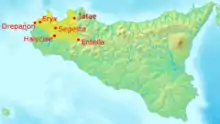Elymians
The Elymians (Latin: Elymī) were an ancient tribal people who inhabited the western part of Sicily during the Bronze Age and Classical antiquity.

Origins
According to Hellanicus of Lesbos, the Elymians were a population of Italic origin, who arrived in Sicily after having fought a war with the Oenotrians.[1] Furthermore for the Greek historian, the Elymians would also have contributed to the formation of the Sicels.[2] Today this thesis seems to be the most accredited and is confirmed by linguistic studies.[3] Elymian, a language for which a different affiliation has long been sought in the past, must also be attributed to this linguistic family (Indo-European); however, the ancient tradition according to which the Elymians came from Troy is corroborated by the linguistic data but today the most authoritative opinions see in Elymian an Italic language more or less similar to Latin.[4] [5]
Greek historian Philistus refers to the presence of a people of Ligurian origin, although he does not identify it with the Elymians.[6] In modern times, historians such as Heinrich Nissen and Karl Julius Beloch investigated the possibilities of a Ligurian origin following the numerous common epigraphic and toponymic references, still found in the cities of Lerici, Segesta and Entella.[4]
Apart from mythological tales, there is little known about the identity and culture of the Elymians. They are indistinguishable from their Sicani neighbours in the archaeological record of the early Iron Age (c. 1100–c. 700 BC). Thereafter they appear to have adopted many aspects of the culture of the Greek colonists of Sicily, erecting the remarkable temple at Segesta and using the Greek alphabet to write their own language. As yet, no one has succeeded in deciphering the Elymian language.[4]
The archaeological excavations of the Elymian centers show clear affinities with Anatolian pottery, in particular from the Troas region.
History
The Elymians maintained friendly relations (and alliances) with Carthage but came into frequent conflict with the expansionist Greek colonies of western Sicily, especially Selinus. Boundary disputes with Selinus broke out into open warfare on several occasions after 580 BC. They sought to ally first with Athens against Selinus, provoking the disastrous Sicilian expedition of 415–413 BC. Following this failure they encouraged the Carthaginians to attack Selinus in 409 BC and succeeded in obtaining the destruction of their rivals.
However, they turned on Carthage during the First Punic War and allied with Rome instead. The Elymians were granted a privileged status under Roman rule and were exempted from taxes. This was said to have been in recognition of the Elymians' claim of Trojan ancestry, which was seen as making them cousins of the Roman people, who also claimed to have been descended from the Trojans. The Elymians appear to have largely disappeared from view under Roman rule, presumably becoming assimilated into the general Sicilian population.
Areas of settlement

The Elymi shared western Sicily with the Sicani, the Phoenicians, and later the Greeks. Their three most important cities were Segesta, the political centre; Eryx (the modern Erice), a religious centre; and Entella. Other cities were Elima, Halyciae (referred to as Alicia in modern Italian sources), Iaitas, Hypana, and Drepanon.
References
- "Gli Elimi: storia e archeologia di Segesta, Erice, Entella". www.arkeomania.com. Retrieved 2021-12-26.
- Aloni, Antonio; Ornaghi, Massimiliano (2011). Tra panellenismo e tradizioni locali: nuovi contributi (in Italian). Claudio Meliadò. ISBN 978-88-8268-029-9.
- "Elimo". lila.sns.it (in Italian). Retrieved 2021-12-26.
- "ELIMI in "Enciclopedia Italiana"". www.treccani.it (in Italian). Retrieved 2021-12-26.
- Tribulato, Olga (2015). "Interferenza grafemica ed interferenza linguistica nella Sicilia antica" (PDF). Università Ca' Foscari Venezia, Italia.
- Braccesi, Lorenzo (1993). Hesperìa: studi sulla grecità di occidente (in Italian). L'ERMA di BRETSCHNEIDER. ISBN 978-88-7062-809-8.
Sources
- Giulia Falco: Elymoi. In: Der Neue Pauly (DNP) vol. 3, Metzler, Stuttgart 1997, ISBN 3-476-01473-8, Sp. 1003.
- Simona Marchesini: "The Elymian language"' in Olga Tribulato (ed..): Language and Linguistic Contact in Ancient Sicily. Cambridge University Press, 2012:95–114.
Further reading
- Cohen-Skalli, Aude (2011). "Le témoignage de Diodore de Sicile sur deux cités élymes: Ségeste et Éryx (VIe et Ve siècles av. J.-C.)" [The evidence of Diodorus of Sicily on two Elymian cities: Segesta and Eryx (VIth and Vth century B. C.)]. Dialogues d'histoire ancienne. Supplément n° 6: Diodore d’Agyrion et l’histoire de la Sicile: 137–153. doi:10.3406/dha.2011.3571.
